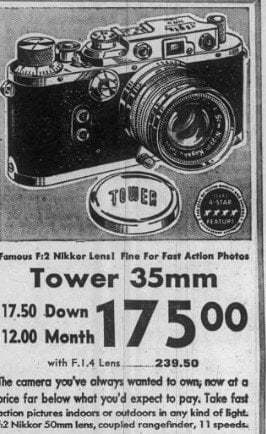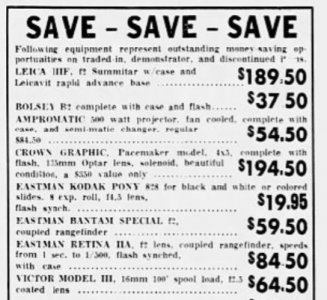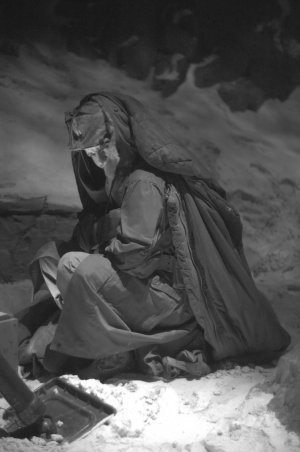So- notice that I did not include the LTM wartime 5cm F1.5 Sonnar in the comparison?
1943 Sonnar 5cm F1.5, LTM. This lens is optically perfect. BECAUSE the middle triplet was loose in the barrel and the lens required me to tighten it in to keep in focus. So- 60+ years after being made, it was repaired by me.

Optically superior to "all the above". The Barrel and Focus mount of the Zeiss LTM wartime lenses: flimsy. Poorly designed and never would have stood up to the demands of a wartime photographer. Focus stop screw is through the focus ring. Material for the LTM mount is second-rate. I have one LTM wartime Sonnar that required a guide for the barrel to move through the mount as the threads were worn down by Sand that had gotten into the mechanism. My opinion: Zeiss was ordered to make Sonnars in Leica mount and did not want anything surviving more than 5 years. Eighty years later: my best Wartime Sonnars are ones that I transplanted into Jupiter-3 mounts made much later.
1943 Sonnar 5cm F1.5, LTM. This lens is optically perfect. BECAUSE the middle triplet was loose in the barrel and the lens required me to tighten it in to keep in focus. So- 60+ years after being made, it was repaired by me.

Optically superior to "all the above". The Barrel and Focus mount of the Zeiss LTM wartime lenses: flimsy. Poorly designed and never would have stood up to the demands of a wartime photographer. Focus stop screw is through the focus ring. Material for the LTM mount is second-rate. I have one LTM wartime Sonnar that required a guide for the barrel to move through the mount as the threads were worn down by Sand that had gotten into the mechanism. My opinion: Zeiss was ordered to make Sonnars in Leica mount and did not want anything surviving more than 5 years. Eighty years later: my best Wartime Sonnars are ones that I transplanted into Jupiter-3 mounts made much later.
Last edited:
wlewisiii
Just another hotel clerk
(referring to the first pair of sonnar/xenar shots  )
)
That's what I though simply because of what you said about bloom. In my Contax/Kiev days, I had a beautiful collapsible prewar 50/2.8 Tessar that was uncoated but had a wonderful bloom on it. It gives a very distinctive look - even more so with color film. It was exquisite with Fuji Reala in a way that I didn't realize was special at the time.
That's what I though simply because of what you said about bloom. In my Contax/Kiev days, I had a beautiful collapsible prewar 50/2.8 Tessar that was uncoated but had a wonderful bloom on it. It gives a very distinctive look - even more so with color film. It was exquisite with Fuji Reala in a way that I didn't realize was special at the time.
Jason Schneider
the Camera Collector
The uncoated 50mm f/1.5 Leitz Xenon, the one with Taylor-Hobson markings, was certainly fascinating and collectible but was never a stellar performer (I never shot with one, so I'm relying on the reviews of others who did). I am therefore hardly surprised that the matching shot taken with the postwar 50mm f/1.5 Nikkor is sharper, more detailed and has higher contrast, Nice comparison though.Two 5cm F1.5 lenses available in the Late 1940s for the Leica.
and
One is the Nikkor 5cm F1.5, wide-open and the other is my Clean Glass Leitz Xenon that has been cleaned of haze. The Xenon is uncoated, but has a beautiful bloom. Mine is from the last batch.
As if anyone needs to ask- Nikkor is the top one.
Pál_K
Cameras. I has it.
That is the truth! There was also Modern Photography’s comparative lens tests. I can only imagine the amount of work involved in designing and performing the tests and summarizing the results; I’ve not seen anything like it since.Reading this article makes me realize how much I miss Popular Photography where each month I looked for Jason's section before looking at anything else…
But we are very fortunate to have Jason here!
Last edited:
xayraa33
rangefinder user and fancier
I always liked the superb mechanical construction of the Takumar lenses from about 1964 to 1976, and loved Rokkor lenses on how they draw photographically.
I remember an article where you might have called the Xenon a disaster of a collaboration... I found this one at a great price, looked it up and it was made in the last batch. Heavy internal haze, the reason it was so cheap. It cleaned up well. SO- the Nikon and Zeiss 5cm F1.5 lenses definitely blew the Leica "Super-speeds" out of the water in the 1940s and 1950s.The uncoated 50mm f/1.5 Leitz Xenon, the one with Taylor-Hobson markings, was certainly fascinating and collectible but was never a stellar performer (I never shot with one, so I'm relying on the reviews of others who did). I am therefore hardly surprised that the matching shot taken with the postwar 50mm f/1.5 Nikkor is sharper, more detailed and has higher contrast, Nice comparison though.
Last edited:
Jason Schneider
the Camera Collector
"You get what you pay for"may be good general advice, but in the early to mid 1950s Nikon, Canon, Pentax, Topcon, and other Japanese companies were all selling lenses comparable to and competitive with the top German makers at substantially lower prices--typically about 30% less. Nikon did offer the 50mm f/1.1 Nikkor to elevate their image and demonstrate their technical prowess, but the lens that really established the Nikon S-series rangefinder camera was the 50mm f/1.4 Nikkor-S.C, which sold in far greater numbers and can hardly be described as a "kit" or "bundled" lens.it always seems to me that the relative cost of a lens when offered new on the market is usually a pretty good indicator of its quality/performance. I think that the f/1.4 and f/2 Nikkor lenses could be analogized to a "standard 50mm f/1.8" that came with every SLR. While standard (bundled) lenses can be very good, SLR manufacturers offered lower-volume 1.4s and 1.2s at much higher price points for the pros. For instance, Nikon had the f/1.1 lens as its marquee 50mm. Later Canon RFs had the 50mm f/1.8 as their standard bundled lens, a capable but not remarkable lens. But Canon also offered better, faster, and more expensive 50s.
dexdog
Mentor
Brian, I don't know that I would call those lenses flimsy, after all there are certainly enough of them around still in working order after 80 years. I agree that they are not particularly robust construction, I think that the crappy alloy they were built with is the biggest drawback. Construction using the traditional brass would have made a much stronger lens.The Barrel and Focus mount of the Zeiss LTM wartime lenses: flimsy. Poorly designed and never would have stood up to the demands of a wartime photographer. Focus stop screw is through the focus ring. Material for the LTM mount is second-rate. I have one LTM wartime Sonnar that required a guide for the barrel to move through the mount as the threads were worn down by Sand that had gotten into the mechanism. My opinion: Zeiss was ordered to make Sonnars in Leica mount and did not want anything surviving more than 5 years. Eighty years later: my best Wartime Sonnars are ones that I transplanted into Jupiter-3 mounts made much later.
What other lens can you think of that has the near/far focus mechanism using a screw that goes through the focus ring? The Jupiter-3 mechanism changed to use an internal screw for the near/far stop. With the J-3, you can correct the RF Cam not going to infinity by moving the helical farther into the mount, then re-indexing the focus ring to come back to the top of the lens. With the Zeiss design, the external set screw has to stay in phase with the guide on the helical. I guess you could tap out a new hole for the focus stop screw- but what a Pain! True that many of these wartime Sonnars are still working after 80 years- but I've seen several that were worn out from heavy use. I still have the one that had seen rough use, filled with sand and grit. I used vacuum pump grease to steady up the helical, and still had to make a sleeve for it. Optically decent, about 1/2 of the coating on the front element worn off. I'm still of the opinion that Zeiss was ordered to make lenses for the Leica, and did not put the A team or the B team on designing a focus mount. Looking at the focus stop screw, at work we would say "What idiot came up with that idea". I would expect better of an engineer working for Zeiss. Unless they just did not want to do the lens, and wanted something that would not last under heavy use.Brian, I don't know that I would call those lenses flimsy, after all there are certainly enough of them around still in working order after 80 years. I agree that they are not particularly robust construction, I think that the crappy alloy they were built with is the biggest drawback. Construction using the traditional brass would have made a much stronger lens.
Last edited:
Mark C
Well-known
It seems like the coated Summarit would be the fair comparison; I think you mentioned a Summarit you've adjusted to focus close wide open, but don't recall if that was coated. I'm not saying it will match the Nikkor, but the Summarit seems like a respectable performer to me. I compared one with an Opton Sonnar and it was hard to say one was overall better than the other. The biggest problem with the Summarit for me is the difficulty focusing wide open at the indoor distances where f1.5 is most useful. I never knew they were front focusing (not as obvious as back focus), and just thought they weren't any good wide open; I suspect a lot of people felt the same. Maybe in areas like NYC these focus shift issues were common knowledge, but certainly not with anyone I knew - Jason?I remember an article where you might have called the Xenon a disaster of a collaboration... I found this one at a great price, looked it up and it was made in the last batch. Heavy internal haze, the reason it was so cheap. It cleaned up well. SO- the Nikon and Zeiss 5cm F1.5 lenses definitely blew the Leica "Super-speeds" out of the water in the 1940s and 1950s.
The Summarit does better than the Xenon. I picked the Xenon for the comparison as they were both manufactured at the same time. The Xenon was optimized for close-up at F1.5, did not front focus like the Summarit. The Summarit slightly revised the formula, is coated, and has a round aperture. The Hex shape of the Xenon is to mitigate focus shift when stopping down.It seems like the coated Summarit would be the fair comparison; I think you mentioned a Summarit you've adjusted to focus close wide open, but don't recall if that was coated. I'm not saying it will match the Nikkor, but the Summarit seems like a respectable performer to me. I compared one with an Opton Sonnar and it was hard to say one was overall better than the other. The biggest problem with the Summarit for me is the difficulty focusing wide open at the indoor distances where f1.5 is most useful. I never knew they were front focusing (not as obvious as back focus), and just thought they weren't any good wide open; I suspect a lot of people felt the same. Maybe in areas like NYC these focus shift issues were common knowledge, but certainly not with anyone I knew - Jason?
das
Well-known

This is a clipping from Tucson Citizen from August 1955. Looks like the 1.4 was an option at the time for about $65 more dollars. That is about $700 today, so not an insignificant sum. Thank God for layaway!
Just from looking at some newspaper ads, in 1955, by then-long-in-the-tooth, probably used Leica IIIf with the f/2 Summitar and Leicavit (!) could be found on sale for $190! It seems that the normal retail price of the Leica IIIF + Summitar was around $250-300 by the latter part of 1955.

JMF
Established
Last edited:
JMF
Established
JMF
Established
JMF
Established
JMF
Established
some photos taken with a Zeiss R-Sonnar f1.5 CZ from 1942 on M10-P:

50 R-Sonnar CZ f1.5 1942 by JM__, on Flickr

50 R-Sonnar CZ f1.5 1942 by JM__, on Flickr

50 R-Sonnar CZ f1.5 1942 by JM__, on Flickr

50 R-Sonnar CZ f1.5 1942 by JM__, on Flickr
JMF
Established
same as above

50 R-Sonnar CZ f1.5 1942 by JM__, on Flickr

50 R-Sonnar CZ f1.5 1942 by JM__, on Flickr

50 R-Sonnar CZ f1.5 1942 by JM__, on Flickr
Cheers,
JM

50 R-Sonnar CZ f1.5 1942 by JM__, on Flickr

50 R-Sonnar CZ f1.5 1942 by JM__, on Flickr

50 R-Sonnar CZ f1.5 1942 by JM__, on Flickr
Cheers,
JM
Last edited:
Share:
-
This site uses cookies to help personalise content, tailor your experience and to keep you logged in if you register.
By continuing to use this site, you are consenting to our use of cookies.











